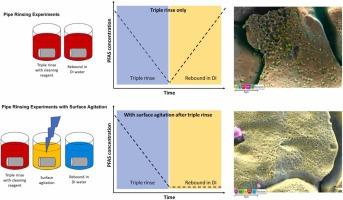Practical Limits of Current Technologies in Removing Per- and Polyfluoroalkyl Substances from Fire Suppression Systems
IF 12.2
1区 环境科学与生态学
Q1 ENGINEERING, ENVIRONMENTAL
引用次数: 0
Abstract
Several commercial products have been broadly marketed for their effectiveness in removing residual PFAS from AFFF-impacted fire suppression systems. However, a comprehensive assessment of their effectiveness in mitigating long-term PFAS rebound following the initial cleaning has not been reported. Herein, batch and flow-through experiments were conducted to interrogate the overall effectiveness of four different cleaning solutions in removing residual PFAS from AFFF-impacted stainless steel pipes from a fire suppression system. Advanced surface imaging techniques were also employed to correlate with bench-scale testing results and to provide insights into potential PFAS rebound mechanisms. Results presented herein demonstrate that complete removal of PFAS from AFFF-impacted fire suppression systems is extremely difficult to achieve for all four cleaning solutions examined in this study. The PFAS rebound behavior observed was likely attributable to PFAS supramolecular assemblies accumulating on the pipe surfaces. Because PFAS rebound following cleanout of AFFF-impacted fire suppression systems is likely inevitable, there needs to be an understanding of the practical limits to which impacted fire suppression system cleanout can be achieved. Improved insights into the dissolution mechanisms and the rate of dissolution of supramolecular formations will be key to improving PFAS decontamination processes and decontamination of materials/equipment impacted by AFFFs.

从灭火系统中去除全氟和多氟烷基物质的现有技术的实际局限性
有几种商业产品因其能有效清除受 AFFF 影响的灭火系统中残留的 PFAS 而被广泛推广。然而,对这些产品在初步清洁后减轻全氟辛烷磺酸长期反弹的效果进行全面评估的报道却寥寥无几。在此,我们进行了批量和流动实验,以检验四种不同的清洁溶液在去除灭火系统中受 AFFF 影响的不锈钢管道中残留的 PFAS 方面的总体效果。此外,还采用了先进的表面成像技术,以便与台架试验结果进行关联,并深入了解潜在的 PFAS 反弹机制。本文介绍的结果表明,对于本研究中检测的所有四种清洁溶液来说,要完全清除受 AFFF 影响的灭火系统中的 PFAS 都非常困难。所观察到的 PFAS 反弹行为很可能是由于管道表面积累了 PFAS 超分子集合体。由于在清理受 AFFF 影响的灭火系统后,PFAS 反弹可能不可避免,因此需要了解受影响的灭火系统清理所能达到的实际极限。更好地了解超分子结构的溶解机制和溶解速度将是改进 PFAS 净化过程和净化受 AFFF 影响的材料/设备的关键。
本文章由计算机程序翻译,如有差异,请以英文原文为准。
求助全文
约1分钟内获得全文
求助全文
来源期刊

Journal of Hazardous Materials
工程技术-工程:环境
CiteScore
25.40
自引率
5.90%
发文量
3059
审稿时长
58 days
期刊介绍:
The Journal of Hazardous Materials serves as a global platform for promoting cutting-edge research in the field of Environmental Science and Engineering. Our publication features a wide range of articles, including full-length research papers, review articles, and perspectives, with the aim of enhancing our understanding of the dangers and risks associated with various materials concerning public health and the environment. It is important to note that the term "environmental contaminants" refers specifically to substances that pose hazardous effects through contamination, while excluding those that do not have such impacts on the environment or human health. Moreover, we emphasize the distinction between wastes and hazardous materials in order to provide further clarity on the scope of the journal. We have a keen interest in exploring specific compounds and microbial agents that have adverse effects on the environment.
 求助内容:
求助内容: 应助结果提醒方式:
应助结果提醒方式:


